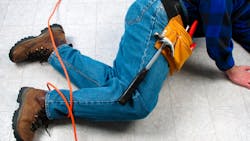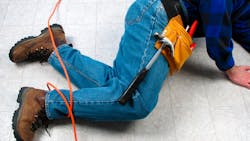The most recent data from the 2012 Liberty Mutual Workplace Safety Index listed the top five leading causes of injuries for 2010. These injuries accounted for 73.1 percent of the total 2010 cost burden:
- Overexertion. Injuries from excessive lifting, pushing, pulling, holding, carrying or throwing accounted for 26.8 percent of the cost burden and accounted for $13.61 billion in direct costs.
- Fall on same level. These injuries accounted for 16.9 percent of the cost burden and $8.61 billion.
- Bodily reaction. Injuries from bending, climbing, reaching, standing, sitting, slipping or tripping without falling accounted for 11.4 percent and $5.78 billion.
- Fall to lower level. These falls accounted for 10.0 percent of the cost burden and $5.12 billion.
- Struck by object. Workers struck by objects such as a tool falling from above accounted for 8.0 percent and $4.10 billion.
What can we do to reduce these injury causes?
For overexertion, I’ve worked with nurses and other workers at different facilities and it has all come to a pretty common answer: Get help if available or use devices to assist with the task if possible. The problem is that’s not always possible. For those that do not have the luxury of help or assistance proper technique and training is recommended.
Proper housekeeping is one way to reduce injuries from falls. Keeping your work area clean and clutter-free is very important in preventing these kinds of injuries. Also, using anti-slip coatings on floors or wearing anti-slip footwear might help reduce falls. ·
Some important ways to reduce bodily reaction injuries include eliminating environmental factors that can cause these injuries. Be aware of hazards that can cause injuries, such as improper placement of tools or clutter around your workstation. Also, maintain a healthy lifestyle with proper physical conditioning and prevent situations that carry prolonged awkward posture.
In preventing falls to lower levels, always make sure ladders are in proper working order and scaffolding has been built and repaired correctly. It’s important to make sure that these tools are inspected and maintained regularly. Also, remember to where proper fall protection where applicable.
A few of the simpler ways to reduce injuries caused by “struck-by objects” include: wear hardhats to avoid falling objects; stack materials properly to prevent sliding, falling or collapse; and always wear proper PPE. This includes safety glasses, goggles and face shields to name a few. Don’t work under cranes, hoists or heavy machinery while it’s being operated. To avoid struck-by incidents with vehicles, workers should wear seat belts, check vehicles thoroughly and wear highly visible clothing.
These are just a few examples of what can be done to reduce these top five injuries in your workplace. With proper training and awareness, these numbers will hopefullly decline and fewer people will be injured on the job.


